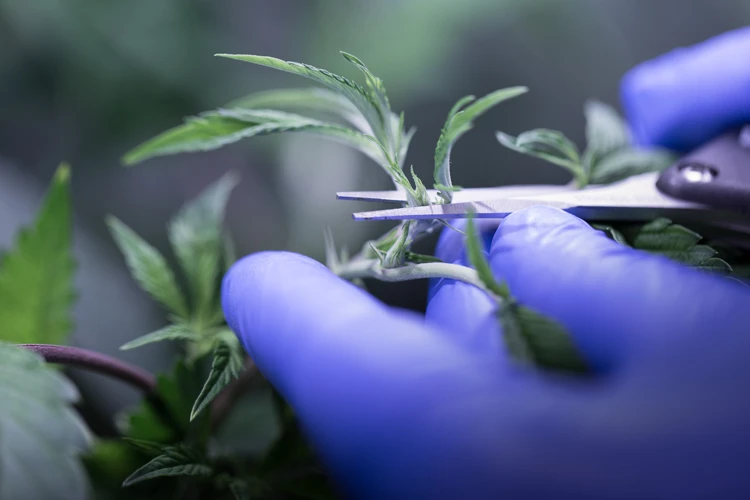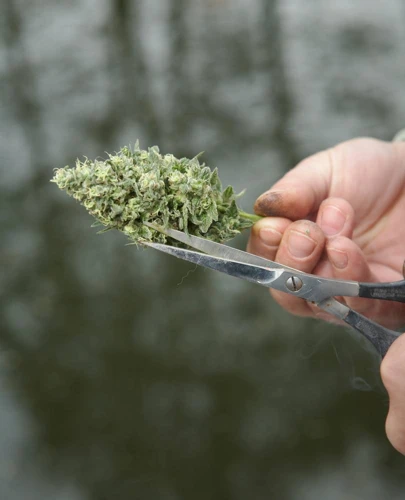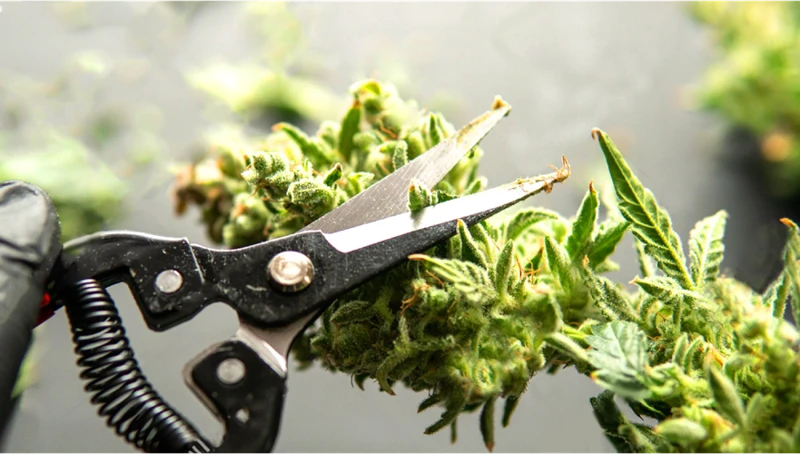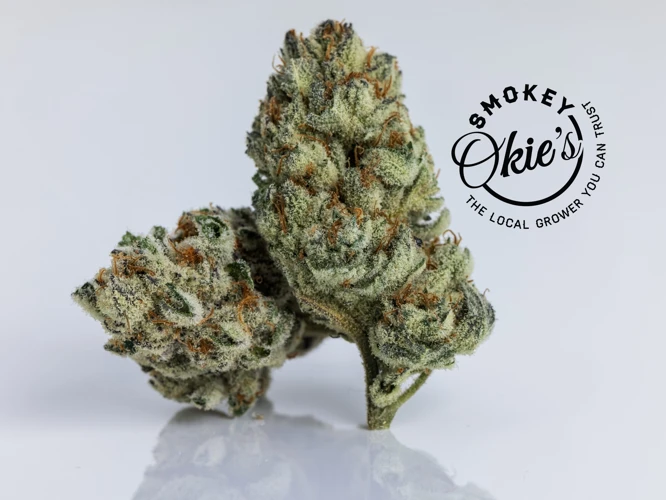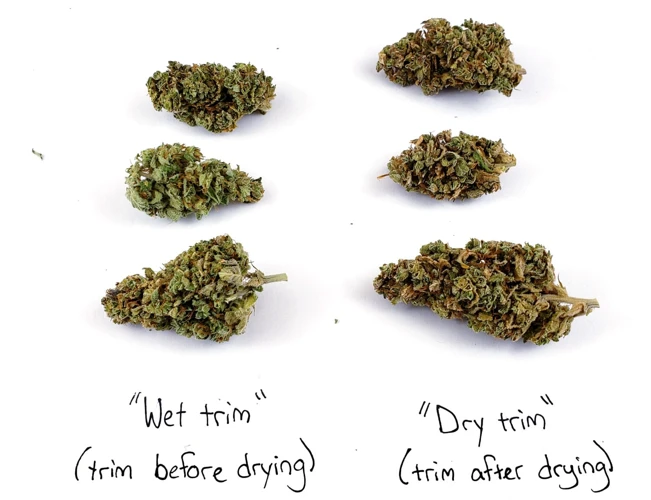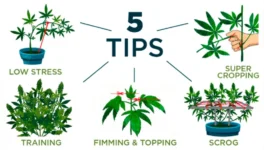
Trimming Techniques for Cannabis Strains
Introduction
Contents
The art of cultivating cannabis is a complex and rewarding process that requires patience, knowledge, and attention to detail. One crucial step in this process is trimming. Proper trimming ensures that the final product is not only aesthetically pleasing but also potent and flavorful. However, with so many trimming techniques available, it can be perplexing to determine which approach is best suited for your specific strain. In this article, we will explore different trimming techniques for different cannabis strains, outlining the benefits and drawbacks of each method to help you make an informed decision.
Why trimming is important
Trimming is a crucial process in the cultivation and harvesting of cannabis. The primary reason for trimming is to remove excess leaves, stems, and other unwanted materials from the buds. Through trimming, the final product achieves a desirable appearance, potency, and aroma.
Here are some reasons why trimming is important:
- Improves potency: Trimming is vital to ensure that the cannabis buds reach their peak potency. By removing excess leaves, the plant channels more energy into the buds, magnifying their THC content.
- Enhances appearance: Trimming gives the cannabis buds a good appearance by removing the excess foliage. By getting rid of the sugar leaves and stems, the buds take on a more attractive and marketable appearance.
- Improves flavour and aroma: Trimming is important in improving the flavour and aroma of the cannabis buds. When the sugar leaves, fan leaves, and stems are eliminated, the trichomes are exposed, and this enhances the buds’ fragrance and overall taste.
- Removes unwanted materials: Trimmed buds greatly reduce the number of unwanted materials that remain in the final product, such as stray leaves, stems, and other undesirable components.
- Ease of smoking: Trimmed buds are easy to smoke and burn evenly, making for a more enjoyable smoking experience.
Trimming is a delicate and time-consuming process that requires some skill and attention to detail. Whether using your hands, scissors, or machines, the result of a proper trim is a high-quality cannabis product that is both visually desirable and potent. For more information on this subject, you can read our article on trimming cannabis buds.
Trimming techniques overview
When it comes to trimming cannabis, there are several techniques that growers can use, each with its own advantages and disadvantages. Here is an overview of the different trimming techniques:
- Finger Trim: This is the most basic and traditional way of trimming cannabis. It involves using your fingers to pluck off the leaves and other unwanted parts of the plant.
- Scissor Trim: A more advanced method, scissor trimming involves using specialized cannabis trimming scissors to cut away the leaves and other unwanted parts of the plant.
- Machine Trim: This technique utilizes mechanical trimmers to quickly and efficiently trim large quantities of cannabis.
In addition to the type of trimmer used, growers must also decide whether to wet trim or dry trim their cannabis. Wet trimming involves removing the leaves and other unwanted parts of the plant immediately after harvesting, while dry trimming involves allowing the plants to dry out first before trimming.
Each trimming technique has its own benefits and drawbacks, and growers should choose the one that best fits their needs and preferences. In the next sections, we will take a closer look at each of these techniques, as well as their respective pros and cons.
Finger Trim
When it comes to manicuring cannabis buds, one of the traditional methods used by growers is the finger trim. This technique involves removing excess leaves and stems from the buds using nothing but your hands, making it a hands-on and labor-intensive process. While it may not be as efficient as other trimming methods, some growers prefer it for its straightforward and organic approach. Let’s take a closer look at when and how to use the finger trim technique, as well as its pros and cons.
When to use finger trim
Finger Trim: When to Use It
When deciding on the best trimming technique for your cannabis plants, it’s essential to consider the stage of growth. Here are some cases when finger trimming would be the best option:
| Scenario | Benefits of Finger Trimming |
|---|---|
| Maintaining Terpene Profile | Finger trimming provides a more delicate touch, which is ideal for preserving the precious trichomes that house the plant’s aroma and taste. |
| Small Batches | If you are working on a small batch of cannabis, consider using finger trimming. The precision of finger trimming will help you keep a consistent product. |
| Delicate Strains | For delicate strains that have fragile trichomes, using the finger trimming technique is ideal. It ensures the trichomes stay intact and prevent damage. |
Finger trimming is a labor-intensive process and is not suitable for large-scale commercial operations. However, if you have a small number of plants and want to maintain the quality of your product, finger trimming is an excellent option. It’s ideal to choose this method when your plants reach their maturity stage, and the buds are ready to harvest.
How to finger trim
To start finger trimming, prepare a clean work area and put on gloves to maintain hygiene. Here’s how to finger trim:
- Pick a Cola: Select a cola to trim and hold it gently but firmly with one hand. Make sure to hold it in a way that will not damage the plant or cause it to break.
- Locate the Sugar Leaves: Identify the sugar leaves on the cola. These are the larger fan leaves that grow from the stem of the cola. They’re called sugar leaves because they contain trichomes, which give them a frosty appearance.
- Trim the Sugar Leaves: Using your other hand, use your fingers to remove the sugar leaves from the cola. Gently pull each leaf away from the bud, being careful not to damage the bud itself. Discard the removed sugar leaves into a waste bag.
- Trim the Remaining Leaves: After removing the sugar leaves, look for any remaining small leaves that don’t contain trichomes, called leaves. Use your fingers to remove these leaves as well, carefully cutting any remaining stems using scissors if necessary. Remember that the more leaves you remove, the more you enhance the quality and aesthetics of your cannabis buds.
- Clean the Buds: Once you have trimmed all the leaves, use a soft-bristled brush or cloth to gently wipe the buds clean, removing any remaining dust or debris. Do this gently so as not to damage the buds or rub off any trichomes.
- Inspect the Trimmings: Examine the trimmings you’ve just cut, as these can be used for other purposes, such as making edibles or concentrates. Collect them carefully and store them as per the method you intend to use them, such as freezing or drying them.
Finger trimming is an intricate process that can take quite a bit of time, but it’s worth it for the improved flavor, aroma, and aesthetics of the buds. After trying it out, you can decide which method works best for your cannabis strain.
Pros and Cons of finger trimming
One of the most traditional ways of trimming cannabis is by using your fingers, which is called finger trimming. This technique may be the oldest but it still has its own set of advantages and disadvantages.
Pros of finger trimming
| Advantages | Description |
|---|---|
| Natural approach | Finger trimming is an all-natural process and does not involve any machinery, making it an eco-friendly alternative. It is the closest method to handpicking, which ensures gentle handling and minimal damage to the buds. |
| More personal touch | Using your fingers to trim your plants allow you to get up close and personal with them. This provides a sense of connection and understanding of each plant and its unique characteristics. You may also spot and remove other unwanted substances like pests or mold while checking over your plants. |
| Preserves terpenes | Finger trimming enables the preservation of terpenes, which are aromatic compounds that contribute to the plant’s flavor and aroma, by minimizing their exposure to the atmosphere or machinery. |
Cons of finger trimming
| Disadvantages | Description |
|---|---|
| Much more time-consuming | Finger trimming can be a laborious and time-consuming process, especially if you have a large number of cannabis plants to trim. It can take several hours, if not days, to trim a crop by hand. This may then lead to a subsequent decrease in the quality of the overall crop due to the long working hours required. |
| Requires training and expertise | You need to have a sufficient amount of experience and training to master the art of finger trimming. Newcomers may have difficulty in keeping up with the required pace, and it may take them some time to get the right trimming techniques, which affects the final product’s quality. |
| Prone to hand fatigue and strain | Trimming by hand can cause hand fatigue and strain, especially if it’s done for extended periods. Fingers and hands can also cramp up as a result of the repetitive motions involved in finger trimming, leading to discomfort and reduced yield. |
While finger trimming may be traditional and eco-friendly, it is also a more tedious and time-consuming approach than other more efficient techniques, requiring experience and training to master, leaving it behind in terms of yield when compared to other methods. Nonetheless, it is advised to give this method a try as its closeness to the plant and natural attitudes can preserve the quality and unique characteristics of each plant.
Scissor Trim
When it comes to trimming your cannabis buds, there are several techniques to choose from – each with its own unique advantages and disadvantages. One of the most popular methods is the use of scissors, which offers precise control over the trimming process. This technique involves trimming your plants manually with a pair of sharp scissors, ensuring that each bud is trimmed to perfection. However, there are specific situations where it is appropriate to use scissor trimming, and it’s important to understand the techniques involved to make the most out of this approach.
When to use scissor trim
There are a few scenarios in which scissor trimming is the best option for cannabis growers. Here are some situations where you might want to choose this trimming technique:
- Small harvests: Scissor trimming is ideal for small harvests, as it allows growers more control over the trimming process, ensuring a higher quality end product.
- Precise trimming: Scissor trimming is perfect for growers who want to trim their buds with great accuracy. This method allows for the removal of the tiniest leaves and buds, creating a clean and manicured appearance.
- High-quality buds: For growers who want to produce the highest quality buds, scissor trimming is the way to go. This technique provides the precision necessary to remove any unwanted material, leaving only the best part of the plant behind.
- High-end strains: For higher-end strains, scissor trimming is a popular choice since it produces a well-manicured, visually appealing and potent end product that can fetch a premium price.
Scissor trimming is a great choice for growers who want to achieve a premium finished product, especially for small harvests where precision is key. However, it takes patience and time to complete the process and may not be the best option for larger yields.
How to scissor trim
Scissor trimming is a traditional method of trimming cannabis buds that requires the use of a sharp pair of scissors to remove excess leaves from the buds. This method is best used for small-scale operations where attention to detail is crucial. Here is a step-by-step guide on how to scissor trim your cannabis buds:
| Step 1 | Prepare your workspace by laying out a clean surface and making sure that you have good lighting. You will also need a sharp pair of scissors and a container to catch the excess leaves. |
| Step 2 | Start by picking up a bud in one hand and holding it steady. Use the scissors in your other hand to carefully snip off any large leaves that are sticking out of the bud. |
| Step 3 | Next, use the scissors to get in close to the bud and carefully trim off any small leaves that are protruding from the buds. |
| Step 4 | Rotate the bud in your hand and repeat the trimming process around the entire bud. Be sure to take your time and avoid cutting into the delicate buds. |
| Step 5 | Once you have finished trimming a bud, place it into a separate container designated for trimmed buds. |
| Step 6 | Repeat the trimming process for all of your buds. |
Tips: Remember to only trim the excess leaves and not the buds themselves. You should also take breaks often to avoid hand fatigue and ensure that your trimming work is precise. Always remember to clean your scissors between each bud to avoid transferring any debris or contaminates.
Pros and Cons of scissor trimming
Pros:
- Scissor trimming is more precise and allows for more control over the final result. This makes it a good option for smaller grows or when working with delicate plants.
- It can be done at a slower pace, allowing for more attention to detail and a higher level of customization in the final product. This is especially true if using small trimming scissors.
- Scissor trimming can be a more cost-effective option than using a machine trimmer, especially for smaller grows.
- Using scissors allows for easier access to hard-to-reach areas of the plant, such as the small buds or leaves in the center of the plant.
- Scissor trimming is a quieter option than machine trimming, which can be beneficial for growers who want to be less disruptive.
Cons:
- Scissor trimming can be time-consuming, even when working with smaller plants. It requires patience and a steady hand.
- It can be hard on the hands and fingers, especially if working for an extended period of time. This is something to consider for those with arthritis or other hand conditions.
- Depending on the size of the grow, scissor trimming may not be a practical option as it requires a lot of manual labor. This is especially true for larger grows where time is of the essence.
- There is a risk of damaging the plant if not careful, as scissor trimming requires getting very close to the buds and leaves. This can be an issue for those who are new to trimming.
- Scissor trimming can lead to inconsistencies across different plants, especially if working with a large number of them. This can be frustrating if trying to achieve a uniform final product.
Machine Trim
For cannabis cultivators with large harvests, trimming by hand can be a tedious and time-consuming task. Fortunately, machine trimming can significantly cut down on the time and labor required. These trimming machines come in various sizes and types to suit different types of cannabis strains and quantities. Using a trimming machine may appear straightforward, but there are various techniques to keep in mind to ensure optimal results. Here’s what you need to know about machine trimming your cannabis harvest.
When to use machine trim
Determining when to use machine trim is an important decision for cannabis cultivators. Here are some considerations to keep in mind:
| Consideration | Description |
| Quantity of cannabis to process | Machine trimming is ideal for large quantities of cannabis, as it can trim hundreds of pounds in a short amount of time. |
| Cost | Machine trimmers can be expensive, and may not be cost-effective for smaller cultivators or those with a limited budget. |
| Quality control | Machine trimming can sometimes damage the buds or remove too much plant material, leading to lower quality cannabis. |
| Desired trim style | Machine trimmers typically produce a rougher, less precise trim than hand trimming, which may not be desirable for certain strains or products. |
| Labor savings | Machine trimming can save significant amounts of labor and time, freeing up cultivators to focus on other aspects of the growing process. |
As with all trimming techniques, there are pros and cons to using a machine trimmer. It is important for cultivators to carefully consider their specific needs and priorities before deciding on a trimming method.
How to machine trim
Machine trimming is a popular option for trimming cannabis quickly and efficiently. Here, we’ll take a look at the step-by-step process of machine trimming cannabis:
| Step 1: | Prepare the machine. Make sure the blades are clean and sharp. You may need to adjust the height or speed settings of the machine depending on the strain being trimmed. |
| Step 2: | Prepare the cannabis. Remove any large fan leaves and trim the sugar leaves if desired. You may want to freeze the cannabis before trimming to make it easier to handle. |
| Step 3: | Load the cannabis into the machine. Be sure not to overload it or the quality of the trim may suffer. |
| Step 4: | Turn on the machine and let it do its job. Depending on the size of the machine and the amount of cannabis being trimmed, it may take anywhere from a few minutes to a few hours. |
| Step 5: | Inspect the trim. Once the machine has finished, remove the trimmed cannabis and inspect it. You may need to do some touch-up trimming by hand to remove any remaining excess leaves. |
| Step 6: | Clean the machine. After you’re finished trimming, be sure to clean the machine thoroughly so that it is ready for the next use. |
Tips:
- When machine trimming, it’s important to make sure the blades are clean and sharp to ensure the quality of the trim.
- Be careful not to overload the machine or the quality of the trim may suffer.
- Inspect the trim carefully after machine trimming to ensure that it meets your desired quality standards.
Pros and Cons of machine trimming
When it comes to trimming cannabis strains, machine trimming has both advantages and disadvantages. Here are some of the pros and cons of machine trimming:
| Pros | Cons |
|---|---|
|
|
While machine trimming can be very efficient and cost-effective, it is important to carefully consider the potential downsides before choosing to use this method. In some cases, hand trimming or using handheld trimmers may be a better option to ensure the highest quality product.
Wet Trim vs Dry Trim
When it comes to trimming cannabis, there are two main techniques used: wet trimming and dry trimming. These methods refer to when the trimming process takes place in relation to the plant’s harvesting and drying process. Each method has its advantages and disadvantages, and choosing the right method can impact the final quality of the cannabis product. Let’s take a closer look at the differences between wet trimming and dry trimming and explore the pros and cons of each method.
When to use wet trim
Wet trimming is the process of trimming your cannabis flowers when they are still moist or wet after harvest. This technique is ideal for those who want to preserve the appearance and aroma of their cannabis buds to the highest possible extent. Here are some situations where wet trimming might be the best choice:
- When you’re dealing with strains that are particularly delicate or prone to damage during the trimming process.
- When you’re short on time and need to trim your buds as quickly as possible.
- When you want to preserve the look and smell of your cannabis buds for aesthetic purposes, such as if you plan on using them for display or selling them to customers.
- When you’re dealing with a large volume of cannabis buds and want to streamline the trimming process.
Wet trimming is a popular choice among growers for its ability to produce visually appealing and aromatic cannabis buds. However, it’s important to keep in mind that this method requires careful attention to detail to avoid causing damage to the delicate buds. If done correctly, wet trimming can produce some of the most beautiful and fragrant buds you’ve ever seen.
When to use dry trim
Dry trimming can be extremely effective when certain conditions are met. Here are some situations where dry trimming might be the best choice:
- Humidity: If the humidity is low, dry trimming may be the best option. When humidity is low, the buds will dry out more quickly, making it easier to remove the leaves.
- Personal preference: Some people insist that dry trimming produces a better final product. If you have experience with both wet and dry trimming and you prefer dry trimming, then go for it!
- Storage space: If you don’t have a lot of space to dry your buds, you may prefer dry trimming. When you wet trim, the leaves and stems take up more space, which can make it more difficult to dry your buds.
- Outdoor grows: If you grow your cannabis outdoors, dry trimming might be the way to go. Since outdoor grows are exposed to more elements, there’s a greater likelihood of mold or mildew developing during the drying process. Removing the leaves before drying can reduce the risk of mold or mildew affecting your buds.
No matter which technique you choose, it’s important to remember that trimming is an essential part of the cultivation process. Take your time and choose the method that works best for your situation. With a little practice, you’ll be able to produce beautiful, high-quality buds that are sure to impress.
Pros and Cons of wet and dry trimming
There are pros and cons to both wet and dry trimming methods that cannabis growers should consider before making a decision.
Pros of wet trimming:
- Wet trimming can be a faster process because the leaves are still moist and easier to work with.
- It can also result in a cleaner finished product since the excess plant material is removed before drying, reducing the risk of mold and mildew growth.
- Wet trimming can lead to a better overall appearance of the final product since the leaves are tighter to the buds.
Cons of wet trimming:
- It can be more difficult to judge how much plant material to remove in wet trimming since the leaves and stems are still moist and harder to distinguish from the buds.
- Removing the leaves while they are still wet can also result in the loss of some valuable resin and trichome content.
- Wet trimming requires a quick turnaround time since the leaves will begin to wilt and may even start to mold if not removed quickly enough.
Pros of dry trimming:
- Dry trimming allows for a longer window of time in which to trim since the plant material is already dried.
- Dry trimming can potentially lead to higher levels of THC and other cannabinoids since the trichomes have more time to develop and mature during the drying process.
- Dry trimming may also result in a better flavor and aroma since the plant has had time to cure and the flavors have had time to develop.
Cons of dry trimming:
- Dry trimming can be a slower process since the leaves and stems are brittle and can break more easily during trimming.
- It can also result in a messier final product since the excess plant material will need to be removed after the buds have been dried, increasing the risk of contaminating the buds with mold and mildew.
- Dry trimming can be more difficult on the hands and wrists since the plant material is more dry and harder to work with.
Ultimately, the choice between wet or dry trimming will depend on the grower’s preferences and circumstances. Some may prefer the speed and cleanliness of wet trimming, while others may opt for the higher potency and better flavor of dry trimming. It’s important to experiment with both methods and determine what works best for each individual strain and growing environment.
Handheld Trimmers
For those who prefer a more hands-on approach to cannabis trimming, handheld trimmers are a popular tool of choice. These compact trimmers come in a variety of types and styles, each with their own unique benefits and challenges. Whether you’re looking for precision or speed, it’s important to choose the right trimmer for the job and to use it correctly in order to achieve the best results. In this section, we’ll explore the different types of handheld trimmers available and offer some tips for getting the most out of these versatile tools.
Types of handheld trimmers
Handheld trimmers are a convenient tool for trimming small amounts of cannabis. There are different types of handheld trimmers available in the market, each with its own unique features that cater to different needs. Here are some types of handheld trimmers:
- Scissors: Scissors are the most commonly used handheld trimmers. They come in various shapes and sizes, with curved blades being the most popular. A good quality pair of scissors can make trimming a lot easier and efficient.
- Precision Pruners: Precision Pruners are similar to scissors but have a more ergonomic design. They are designed to reduce hand fatigue and are highly recommended for those who need to trim large amounts of cannabis.
- Bowl Trimmers: Bowl Trimmers consist of a bowl-shaped container with a rotating blade that trims the cannabis. They are suitable for those who need to trim small to medium amounts of cannabis.
- Handheld Electric Trimmers: Handheld Electric Trimmers are powered by electricity and are suitable for those who need to trim large amounts of cannabis. They are easy to use and highly efficient.
- Mini Choppers: Mini Choppers are small handheld devices that work similar to a food processor. They are designed to chop cannabis into small pieces and are used for making edibles or concentrates.
Each type of handheld trimmer has its own benefits and drawbacks. It is important to choose the one that suits your needs the best. Investing in a good quality handheld trimmer can greatly improve the efficiency of your trimming process.
How to use handheld trimmers
Handheld trimmers come in several types, including spring-loaded scissors, guillotine-style trimmers, and handheld shears. All of these trimmers require a bit of practice to get the hang of, but with a few tips and tricks, you can quickly become proficient.
Here are the generic steps for using handheld trimmers:
- Prepare your workspace: Before you start trimming, make sure you have a clean and well-lit workspace. Prepare your trimmers by wiping them down with alcohol and lubricating any pivot points.
- Prepare your buds: If you are using scissors or guillotine-style trimmers, you’ll want to remove any large fan leaves with your fingers first. You can also use handheld shears to remove these leaves.
- Begin trimming: Start by holding your buds in one hand and your trimmers in the other. You can either hold your trimmer blades parallel to your buds or at an angle. Some trimmers are designed to work better at specific angles.
- Trim accurately: With a pair of spring-loaded scissors or handheld shears, you can make small cuts along the edges of your buds to remove excess leaf material. With guillotine-style trimmers, you can place your buds into the trimmer and gently press down on the lever to make a clean cut.
- Rotate your bud: After trimming one section of your bud, rotate it to the next section and continue trimming. This will ensure that you are removing all of the excess leaf material, and your buds will be evenly trimmed.
- Clean as you go: Ganja leaves can quickly build up on your trimmers and affect their performance, so make sure to clean them every few minutes. Use a small brush or cloth to remove the sticky residue.
By following these steps, you can quickly master the art of using handheld trimmers and produce beautiful buds for your enjoyment. Remember to take your time and practice regularly to improve your trimming skills.
Conclusion
After exploring the various trimming techniques for different cannabis strains, it is clear that each method has its own pros and cons. The choice of trimming method ultimately depends on various factors, including the size of the harvest, the type of strain, personal preferences, and resources available.
Finger trimming requires patience and precision, but it can yield excellent results in terms of preserving trichomes and maintaining the flavor and aroma of the strain. However, it can be time-consuming and labor-intensive, making it less appropriate for larger harvests.
Scissor trimming is a popular method for medium to large harvests. It allows for more control over the shape and size of the bud, but it can also be time-consuming and tiring on the hands.
Machine trimming is the most efficient and cost-effective method for large harvests, but it can damage the trichomes and affect the overall quality of the buds. It is important to use a high-quality machine that can be adjusted to the specific strain.
Wet trimming and dry trimming are two different approaches to trimming that can yield different results. Wet trimming is much faster, as the leaves and stems are softer and easier to trim. However, it may also result in a loss of potency and aroma. In contrast, dry trimming takes longer but can preserve the trichomes and terpenes better, resulting in a stronger flavor profile.
When it comes to handheld trimmers, there are various options available, from manual trimmers to electric trimmers. It is important to choose a trimmer that is appropriate for the size of the harvest and can be easily adjusted to different strains.
In conclusion, trimming is an important stage in the cultivation process that can greatly affect the final product. By choosing the appropriate trimming method for the specific strain and harvest size, and paying attention to the pros and cons of each method, growers can ensure that their buds are of high quality, potency, and flavor.
Frequently Asked Questions
How can trimming affect the quality of the cannabis?
Trimming can ensure that cannabis buds develop their fullest potential in size and potency, while removing any unwanted parts such as leaves and stems that have low amounts of cannabinoids.
What is the difference between wet trim and dry trim?
Wet trim refers to removing the leaves while the plant is still moist, before the drying and curing process begins. Dry trim, on the other hand, is done after the buds have been dried, which allows for a more precise cut and easier handling.
What equipment do I need for trimming?
Depending on the technique you choose, you may need scissors, handheld trimmers, or a trimming machine. It’s also important to have gloves, a clean environment, and a container for the trimmed buds.
What are the benefits of finger trimming?
Finger trimming allows for a more hands-on approach, which can be helpful for delicate or small buds. It also allows for greater control and precision when removing unwanted parts.
What are the benefits of scissor trimming?
Scissor trimming is a versatile option that can accommodate buds of different sizes and shapes. It also allows for a more consistent cut and can be less tiring on the hands than finger trimming.
What are the benefits of machine trimming?
Machine trimming can save time and labor, especially for large scale operations. It also reduces the risk of contamination or human error in the trimming process.
What are the drawbacks of machine trimming?
Machine trimming can be less precise than other methods, resulting in a less uniform appearance or loss of trichomes. It can also be costly to purchase or rent the necessary equipment.
When is the best time to trim cannabis plants?
Most growers will trim their plants once the buds have reached full maturity, which is usually around week 8-10 of the flowering period.
What should I do with the trimmings and leaves that I remove?
Trimming and leaves can be used to make cannabis concentrates, such as hash or oils. They can also be used in edibles or as a tea.
How do I know which trimming technique is best for my strain?
It generally depends on the size and density of the buds, as well as personal preference and available equipment. Experimenting with different techniques can help determine what works best for a particular strain.

